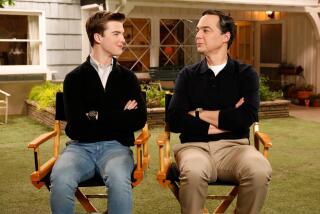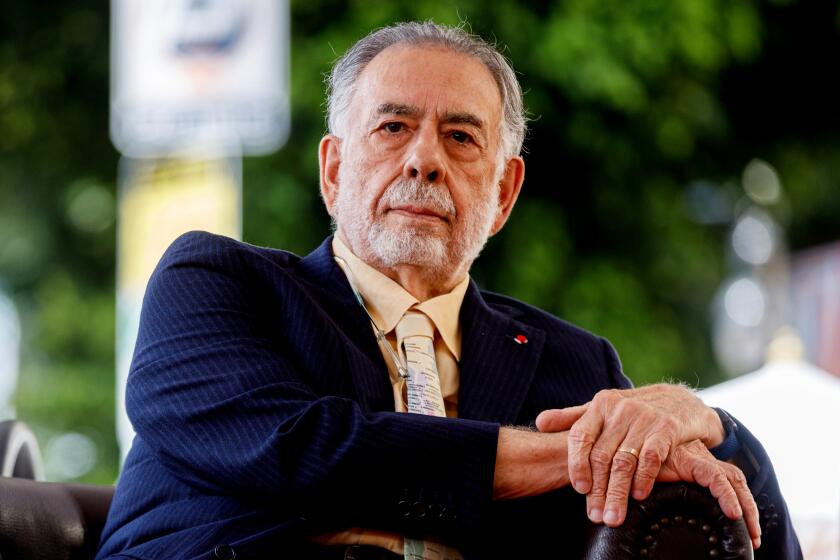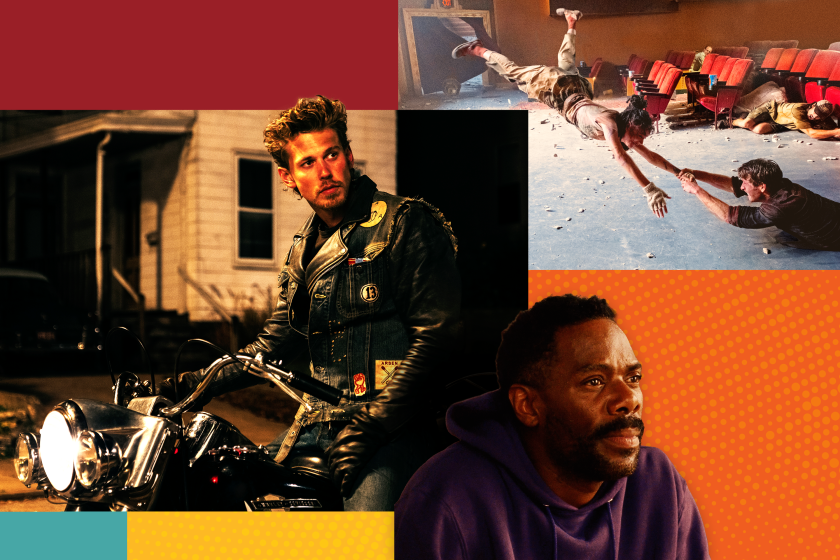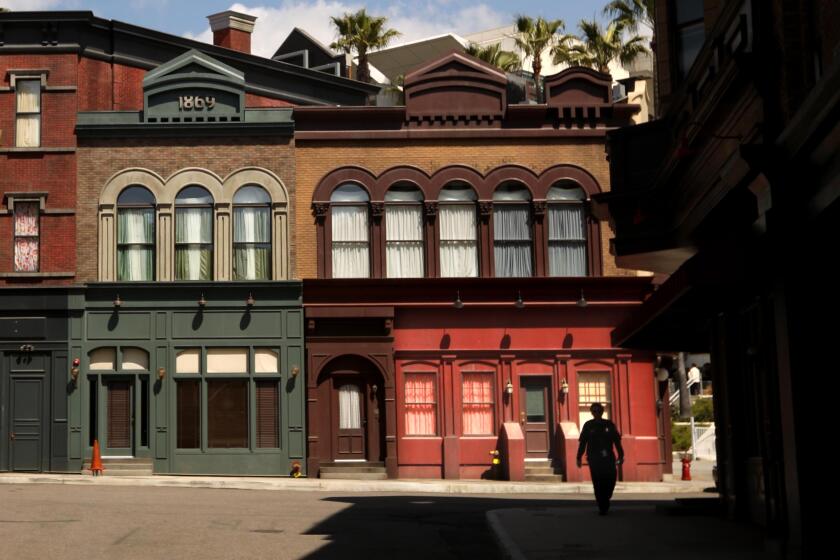Breaking out true hip-hop
It seems appropriate that Rennie Harris, artistic director of Rennie Harris Puremovement hip-hop dance company, would give a moving interview -- that is, from a cell phone while riding in a Philadelphia taxicab on his way to the company studios, located in a former Quaker school building on Lancaster Avenue.
The next day, Harris would head to Oregon, on to Santa Cruz, and then to Los Angeles -- Harris’ new work, “Facing Mekka,” will be performed Wednesday through next Sunday as part of the UCLA Live series.
The evening-length, multimedia “Facing Mekka” -- performed by Harris, a handful of dancers from Puremovement as well as other dancers and artists -- traces the lineage of hip-hop dance from aboriginal, Brazilian and African ceremonial dance all the way up to dance styles born on the urban streets of cities such as New York, Philly, Los Angeles and Fresno. Harris’ research included a voyage to Northern Africa.
The early-morning taxi conversation is interrupted by a few practical asides (“34th and Market Street, please”; something barely intelligible about a large hazelnut cappuccino), but mostly it’s just Harris, trying on the fly to define the undefinable: hip-hop dance.
Here’s the thing: It’s not one thing. Hip-hop is an umbrella term for a myriad of moves, styles and sub-styles. “There are maybe 15 or 20 styles of hip-hop dance,” Harris says. There’s popping, his own specialty, for example -- characterized by sudden stop-action “pops” of individual muscles or entire body parts interrupting the flow of movement.
Popping includes ticking (more accentuated), cracking (even more accentuated), and animation (the most accentuated of all, in which the dancer appears to flicker like an animated character on film). The forms should not be confused with “waving,” when the movement flows more smoothly throughout the body.
Then there’s locking, boogaloo, freestyle or “house” (club dancing, a lot like popping and locking but looser), vogue (whose humorously exaggerated runway posing springs from the gay club scene) and b-boying, often wrongly called “break dancing,” defined by intricate footwork (up rock) and breathtaking spins and handstands done on the floor, usually upside down. This is not a complete list, only what can be spilled out by an earnestly enthusiastic Harris before 34th and Market.
Popping, locking and boogaloo originated on the West Coast and fit into the category of “funk,” now allied with hip-hop, Harris says; b-boy moves started in the East. Each style has its own history, and its own living legend: Don Campbell (creator of “Campbell locking”), Boogaloo Sam, Crazy Legs, and Pop Master Fable, to name a few.
There are many more; Harris -- who at 39 is a veteran of the form -- doesn’t want to leave anybody out. These are the masters, hip-hop’s tribal elders, street dancers who invented the individual words for the hip-hop language in the 1960s, ‘70s and ‘80s, informed by the early onstage moves of rock ‘n’ roll pioneers including James Brown.
Harris sees the difference between “authentic” hip-hop performed by his dancers and the hip-hop seen on TV, in videos and on the pop concert stage -- a hybrid of jazz dance and flashy b-boy acrobatics -- as the difference between hip-hop and hip pop.
“This culture, and specifically pop culture, has kind of convinced people that hip-hop dance is sort of a series of steps and patterns,” Harris says. “A monkey can do that. They do regimented, synchronized movements in the military, but you don’t call it dance. This is not to disrespect that; the point is to let you know that what you are doing right now is not hip-hop, it has evolved into something else. And once it loses the soul, it is no longer dance.”
Keep it real, not in sync
Harris wants to be sure you don’t define hip-hop by the paint-by-numbers ensemble moves executed on stage by boy bands such as ‘N Sync. Authentic hip-hop, Harris says, is decidedly out of sync. Although he admits that a hip-hop choreographer may give a group of dancers a set of moves to perform, they’re not doing it right unless each one looks completely different.
For dancers studying ballet, modern or jazz, Harris explains, the technique, the “steps,” come first -- then later the trained dancer may develop into an individual artist with a unique personality. With hip-hop, Harris believes, it works the other way around.
“Hip-hop has always been a very internal thing, that started from the inside and radiated out,” he says. “It’s the same spirit in jazz, and rock ‘n’ roll. It was rock ‘n’ roll before they called it rock ‘n’ roll, you know? You can’t really capture that and define it.
“People always say: ‘Teach me some dance steps, teach me how to dance.’ To me, there are no dance steps. I tell people to bend their knees; if you want to dance, bounce up and down. You just have to feel the rhythm. It’s not the structure, it’s the spirit.”
That’s why Harris calls his company “Puremovement” -- no definitions, no limits. “Dance is when you are so inspired that your body moves in a way that it doesn’t move in a normal day,” he says. “In a way, hip-hop is just a word.”
In “Mekka,” Harris performs a popping solo titled “Lorenzo’s Oil,” taking the stop-action “pops” usually seen as a fast-paced movement explosion and performing them in what has been described as slow-motion, more akin to butoh than b-boying. Along with the more familiar large, jerking arm and shoulder movements, in the piece Harris also performs more subtle “pops” of neck and face muscles.
“Mekka,” Harris says, is inspired by some of the African dance styles he observed in his travels, but he made no attempt to re-create them. “It’s African by way of lineage and all that kind of stuff, but I didn’t go to Africa and say: ‘Show me a movement and I’ll bring it back here,’ ” he says. “I think that whole process is kind of whacked.
“Everything I used was movement based on my unconscious, whatever influenced me unconsciously. I just took all the movement that I knew was hip-hop, and sort of twisted it around so now it looks like African dance.”
Harris didn’t plan his specialty; it’s just the first style he learned and it works for him. “My style doesn’t have anything to do with the floor, doing flips and stuff like that,” he says. “The only thing I can say by way of the aesthetic is that it is an internal pantomime. Most people who do popping and boogaloo can’t stand the lights, the strobe lights, so they have to create that image themselves.
“Poppers, too, are illusionists,” he adds. “When someone does a flip, you know how they are doing it; it’s just nice to see, visually. That was amazing, but you know the source from which it came. When you watch a popper, you wonder: ‘How is this person making it look like there are no bones in their body?’ They are in a different time warp.”
Although there are no rules to Puremovement, Harris has a different philosophy when it comes to hip-hop dance history and education, the focus of the Illadelph Legends Festival, an annual weeklong event that offers a new generation of dancers the chance to study authentic hip-hop technique in studio master classes, as well as to attend lectures and seminars on hip-hop history.
Or they can simply walk up to the hip-hop pioneers -- including locker Campbell, the Electric Boogaloos or b-boying pioneers the Rock Steady Crew -- and ask.
“A lot of times it’s a rude awakening for a lot of dance groups when we say: ‘What you are doing is not authentic hip-hop, it’s a hybrid,’ ” the dancer says.
The festival also offers the “legends” the opportunity to gather behind closed doors to try to establish a universal vocabulary for the art form, as well as an accurate recorded history of where each style originated, and with whom.
“They are not necessarily orators, or teachers, although some of them do panel discussions,” Harris says. “It’s not so everyone can get to together and say it to the world; it’s so we can have a correct history.”
An example of hip-hop’s quirky lore as told by Kim Cook, Harris’ “sidekick” (that’s the professional title she gives when asked): “A guy named Don Campbell was going to vocational school, his girlfriend had broken up with him, and he was sitting in the cafeteria, he was feeling kind of blue. Some other people were doing the Robot and the Funky Chicken at the time, and he tried to jump in and do it, but he couldn’t get it right. But what he did do looked funny, and people liked it, he got their attention, and he ended up building it into his own style of dance, and touring the world,” Cook says.
“The company and education of hip-hop are two different things for me,” Harris says.
“My passion for dance is something different from my passion for re-educating people about hip-hop. Even though Philadelphia is in the East, it’s not New York; I see it as kind of a hip-conservative place, a neutral place where East meets West. And it’s a place where the legends are learning from each other.
“We have to start now, and be very clear, in acknowledging the masters, they changed a whole culture,” Harris adds. “I couldn’t be doing ‘Facing Mekka’ if I didn’t know the foundations.
“Someone said this to me a long time ago: ‘It will be a sad day when we start to see ourselves as the Little Richards of hip-hop and think that we created it. This stuff is just being institutionalized now, that’s why it’s important that we get together. We tell people about it, but we are still in the throes of doing it. We hope that, through our festival, people will know the inspiration.”
*
‘Facing Mekka’
When: Wednesday-Saturday, 8 p.m.; next Sunday, 7 p.m.
Where: Freud Playhouse, UCLA campus, Wyton Drive entrance, Westwood
Price: $35, $15 with student ID
Contact: (310) 825-2101
More to Read
The biggest entertainment stories
Get our big stories about Hollywood, film, television, music, arts, culture and more right in your inbox as soon as they publish.
You may occasionally receive promotional content from the Los Angeles Times.






